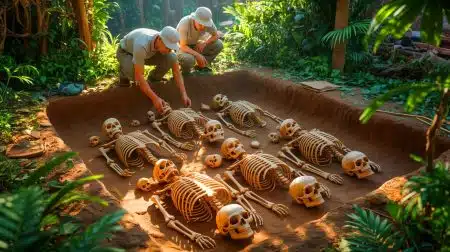| IN A NUTSHELL |
|
In a remarkable archaeological breakthrough, researchers at Cambridge University’s Fitzwilliam Museum have unearthed a 4,000-year-old clay sculpture from an Ancient Egyptian tomb. Known as a “soul house,” this artifact was likely used in burial ceremonies to provide a resting place for the deceased’s soul. The discovery is notable not only for the age and craftsmanship of the sculpture but also for the complete handprint found on its underside. This fingerprint offers a rare glimpse into the life and work of an ancient Egyptian potter, a detail that enriches our understanding of ancient cultures and burial practices.
An Unexpected Glimpse Into Ancient Life
The discovery of the handprint on the soul house has captivated archaeologists and historians alike. As researchers prepared for an exhibition at the Fitzwilliam Museum, they were stunned to find the fingerprints on the bottom of the clay model. This unexpected find provides a unique connection to the past, allowing us to imagine the potter who once crafted the piece.
The soul house itself dates back to the period between 2055 and 1650 BCE. The artifact serves as a tangible link to ancient Egyptian burial rituals, where it was used to house the soul of the deceased. The presence of the handprint adds an intimate, human element to the discovery, making it feel as though we are stepping back in time to witness the creation of this remarkable piece.
Understanding the Creation Process
Researchers have pieced together the likely process used to create the soul house. It is believed that the unnamed potter constructed a framework using wooden sticks before covering it with clay. The structure would then be fired in a kiln, burning away the wooden framework and solidifying the clay sculpture.
The soul house is two stories high, featuring an opening where offerings such as bread would have been placed. The handprint was likely made when the potter lifted the still-wet clay to move it into the kiln. This detail provides a fascinating insight into ancient Egyptian pottery techniques and the day-to-day activities of artisans from that era.
Expert Reactions and Significance
Helen Strudwick, a senior Egyptologist and curator of the exhibition, expressed her excitement about the discovery. According to Strudwick, finding a complete handprint on an Egyptian object is a rare occurrence. “We’ve spotted traces of fingerprints left in wet varnish or on a coffin in the decoration, but it is rare and exciting to find a complete handprint underneath this soul house,” she remarked.
“This was left by the maker who touched it before the clay dried,” Strudwick explained, highlighting the personal connection to the past that the handprint provides. She added, “Things like this take you directly to the moment when the object was made and to the person who made it.”
https://www.sustainability-times.com/research/86000-hidden-earthquakes-uncovered-beneath-yellowstone-reveals-ai-breakthrough-that-changes-everything-about-volcanic-risk/
The Broader Historical Context
The discovery of the soul house and its handprint is not only significant for its direct connection to an ancient artisan but also for its contribution to our understanding of Egyptian burial customs. These practices offer critical insights into the beliefs and social structures of ancient Egyptian society.
Artifacts like the soul house help historians piece together the spiritual and cultural life of ancient Egypt. The presence of offerings and the intricate designs of such artifacts reveal the importance placed on the afterlife and the care taken to ensure the deceased’s well-being in the next world. This discovery, therefore, enriches our comprehension of ancient Egyptian civilization and its enduring legacy.
The soul house discovery serves as a poignant reminder of the enduring human connection across millennia. As researchers continue to explore the secrets of ancient Egypt, each new find offers a deeper understanding of the past. What other hidden stories remain to be uncovered, and how will they continue to shape our perception of history?
Did you like it? 4.4/5 (26)






Wow, a 4,000-year-old handprint! Imagine if we could get the potter’s DNA and find his descendants. 🧬
This is fascinating! How do they date these artifacts so precisely?
Incredible find indeed! Thanks for sharing this discovery. It brings history to life. 👏
Are there any plans to display the soul house to the public soon?
I’m amazed at how much we can learn from a single fingerprint. History is alive!
Was the soul house found intact, or did they have to piece it back together?
So the potter’s handprint is 4,000 years old and mine is just smudged on my phone screen. 🙄
How does this discovery change our understanding of ancient Egyptian burial practices?
It’s just mind-blowing that something so old can be preserved so well!
Do they have any idea what kind of clay was used for the soul house?
Isn’t it amazing that a single handprint can connect us to someone from 4,000 years ago?
So cool! Makes me wonder what other secrets are buried out there waiting to be discovered.
This sounds like something out of an Indiana Jones movie! 🏺
I wonder if the potter ever imagined his work would be a subject of interest millennia later.
Is there any indication of who the potter might have been?
Imagine the potter’s surprise if he knew his handprint would be famous one day. 😆
Such a cool discovery! Makes me want to visit the Fitzwilliam Museum.
Haha, ancient version of a ‘selfie’! The potter left his mark. 😂
Can we expect more finds like this in the near future?
How do they ensure the preservation of such ancient artifacts after they’re discovered?
What does this tell us about the social status of the potter in ancient Egypt?
Is it possible that there are other artifacts nearby waiting to be discovered?
Absolutely love these types of discoveries! Makes history feel so real and tangible. ❤️
What’s the significance of the offerings found with the soul house?
Do they have any theories about what kind of offerings were typically placed inside?
Wow, this is like finding a needle in a 4,000-year-old haystack. 😮
Why is it called a ‘soul house’? That’s such a poetic name.
What challenges do archaeologists face when excavating such ancient sites?
Can’t believe something so ancient still exists. Truly incredible!
I imagine the potter never thought his work would be appreciated in the 21st century!
Any idea what other artifacts were found along with the soul house?
There is hope for life after death.